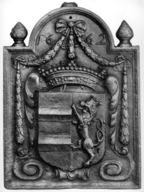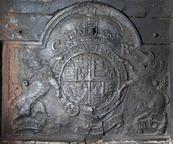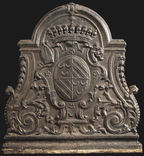-
277
Description: Arched rectangular with cavetto-moulding along top, supported by Ionic pilasters; English Stuart royal shield, garter, helm, crown, motto and supporters; date below and either side of garter.
Notes: One of several firebacks, all of the same date, but varying in size, framing style and moulding; all have stylistic features in common and will have been the work of the same pattern maker, who was also responsible for carving royal coats of arms in three West Country churches. Mendip Auctions, Binegar, 11 Dec 2021, lot 537.
Copies of this fireback are known.
Inscription: I R [Jacobus Rex] / HONI SOIT QVI MAL Y PENSE / 16 18 / DIEV ET MON DROIT
Arms: English Stuart royal (James I)
- Decoration tags:
- rectangular with round arch (shape)
- complex individual (edging)
- whole carved pattern
- architectural
- armorial
- royal
- text
Manufactured: in 1618 possibly in the Forest of Dean area of England.
Current location: not known.
-
1193
Description: Arched rectangular shape with a 'flame' on each shoulder and a broken one on top of the arch; fillet and cavetto-moulded edging; lower centre, shield with impaled arms, dexter two bars in high relief, sinister a crowned lion rampant, all in front of a foliate cartouche terminating in mirrored swirls below the shield; above, a beaded coronet; in the arch, the date split either side of mirrored foliate swags suspended from a bow and from a flower in each shoulder, with a short central vertical swag above the coronet.
Notes: A fireback in high relief with an inserted date.
Inscription: 16 62
Arms: not known
- Decoration tags:
- rectangular with round arch (shape)
- fillet and cavetto (edging)
- whole carved pattern
- individual numbers
- heraldic
- armorial
- text
Manufactured: in 1662 in France.
Current location: English Salvage Ltd, North Road, Leominster, Herefordshire, England.
- Attached to series:
- Foreign armorial firebacks
-
67
Description: Pediment and frieze resting on fluted Tuscan pilasters; plain podium base; rectangular central panel with double fillet edge divided into four with central panel containing initials; date in tympanum; narrow rectangular panels on each side from base to cornice.
Notes: An early example of the use of classical architectural elements in an English fireback.
Inscription: 1568 ER
- Decoration tags:
- rectangular with pediment (shape)
- none (edging)
- whole carved pattern
- individual letters
- extension panels
- architectural
- text
Manufactured: in 1568 in the Weald area of England.
Current location: in private hands, Frant, East Sussex, England.
- Attached to series:
- 1568 Architectural series
- Date & initials firebacks
-
350
Description: Arched rectangular shape; cavetto edging; armorial; Stuart English royal arms within a circular garter; crown, motto and supporters (crowned lion and unicorn); initials separated by crown.
Notes: An early casting of a widely copied fireback. A later copy with an inserted, probably spurious, date is no. 1303.
Copies of this fireback are known.
Inscription: C R / HONI SOIT QVI MAL Y PENSE / DIEU ET MON DROIT
Arms: English Stuart royal
- Decoration tags:
- rectangular with round arch (shape)
- cavetto (edging)
- whole carved pattern
- armorial
- royal
- text
Manufactured: in the mid-17th century in England.
Current location: Knole, Sevenoaks, Kent, England.
(part of the National Trust museum group)
- Attached to series:
- Carolean royal armorial firebacks
- Stuart royal armorial firebacks
-
987
Description: Upon a moulded base plinth, wide scrolled side double fillets with foliage about the scrolls and suspended bell flowers in chain above; central foliate cartouche behind an oval shield surmounted by a vicomte's coronet, with an abbot's mitre to the left and the scrolled top of an abbot's crozier to the right; on top, an arch rising from horizontal moulding on each side, with a small central cartouche enclosing a plain button and a suspended bell flower.
Notes: The quartered arms may include those of Leclerc de Lesseville (az. three crescents or), one of whose number was bishop of Coutances 1659-65.
Arms: ?Leclerc quartering ?
- Decoration tags:
- rectangular with round arch (shape)
- complex individual (edging)
- whole carved pattern
Manufactured: in the late-17th to early-18th century in France.
Current location: not known.
- Attached to series:
- Foreign armorial firebacks




